From the University of Florida Honey Bee Research and Extension Laboratory – Part 3
By: Jamie Ellis
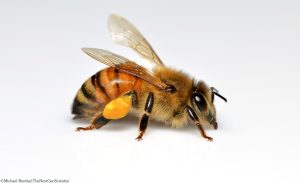
Figure 1. The western honey bee, our test subject. Photograph – Mike Bentley
I hope you have been enjoying the series my colleagues and I have been writing about the University of Florida (UF) Honey Bee Research and Extension Laboratory (HBREL). Our goal is to administer dynamic research, extension and teaching programs focused on the western honey bee (Figure 1). We have been using this article series to give you a sneak peek into the life of the faculty, students and staff of Land Grant University (LGU) honey bee programs. In my first column in the series, I provided a general overview of LGUs and noted that faculty working at LGUs can have responsibilities in research, teaching and extension. In February, my colleague Dr. Cameron Jack discussed the honey bee teaching program at the HBREL. I believe Dr. Jack, who teaches nine different courses on honey bees at UF, has one of the most comprehensive teaching programs focused on honey bees in any academic institution globally. Our team also conducts vibrant extension and research programs. My colleague Amy Vu (UF State Specialized Program Extension Agent – Apiculture) will spend April and May discussing LGU extension programs and introduce you specifically to what our UF program has to offer. That leaves me, this month, to discuss honey bee research programs.
What is science?
Science is the systematic method with which one attempts to understand the physical/natural world. This is accomplished through experiments in which observations are made and theories tested, with the theories ultimately being supported/refuted through the process of experimentation. There are some things science cannot address. I found a great list of the limitations of science at a U.C. Berkley website (Google: “U.C. Berkley – What science cannot do”). From that list, science does not make moral judgments. Second, science does not make aesthetic judgments. Third, science does not tell you how to use scientific knowledge. Finally, science does not (and cannot) draw conclusions about supernatural explanations/events/conditions. I know many folks are intimidated by scientists – thinking we are overly academic, not in tune with the real world, out to disprove the existence of God, etc. In fact, most scientists are just normal humans whose brains really like to solve problems related to the natural world.
Individuals who engage in the practice of science are called scientists or researchers. Scientists do not just sit around and “think” our way to answers. If we did, we would all be philosophers sitting by the fire, wearing our tweed jackets, smoking our pipes and thinking the day away. Instead, scientists use research to answer questions related to the natural world. [Note 1: philo (from the Greek word philein, meaning love) + sophia (wisdom or knowledge); Note 2: philosopher = one who loves knowledge/wisdom; Note 3: Professors usually have a PhD, which stands for “philosophiae doctor” in Latin, or “doctor of philosophy” in English. I really like this imagery because my PhD is in entomology, which literally translates to “lover of the knowledge/wisdom associated with insects”. I think that about sums this up.]
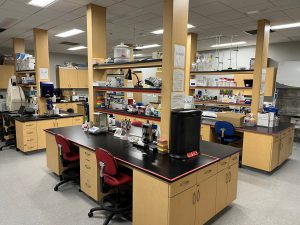
Figure 2. The David J. Mendes Honey Bee Laboratory at the UF HBREL. This laboratory has a number of peripheral rooms that support research on honey bee toxicology, molecular biology, etc. Photograph – Jamie Ellis
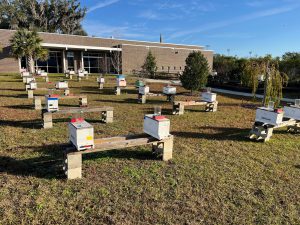
Figure 3. One of the research apiaries at the UF HBREL. Photograph – Jamie Ellis
Faculty at LGUs have a responsibility to conduct research that adds to the human understanding of the natural world and research that ultimately leads to application. This is true, also, for faculty who study honey bees. I always have been a scientist, even if I did not know it during my childhood years. My work as a beekeeper and professor is rooted in my desire to understand how honey bees and their colonies function and how they support ecosystem health and sustainability. This includes research in the laboratory (Figure 2) but also in the field (Figure 3). This is true of most of my research colleagues globally.
How is research conducted?
You likely learned about the scientific method in your elementary or middle school science classes. If so, you will remember that there are multiple steps within this method, steps that one follows when trying to address a question related to the natural world. I know it may seem cliché, but scientists really do follow these steps to address questions related to their discipline.

Figure 4. The Jester Bee Observation Hive Room at the UF HBREL. This room is used to support honey bee behavior research. It can accomodate 12 observation hives. It is red lit to minimize disturbance to the colonies being observed. Photograph – Jamie Ellis
Step 1 – Make an observation. All research starts with an observation that someone makes. Sometimes, the observation is 100% novel. Other times, the observation is made during the execution of an ongoing research project. As an example, a colleague of mine, Dr. Peter Neumann (Professor, University of Bern), was a postdoc in the same research laboratory in which I was a PhD student in South Africa. At the laboratory, Dr. Neumann spent considerable time watching small hive beetle/honey bee interactions in glass observation hives, similar to those we manage in the Jester Bee Observation Hive room at UF (Figure 4). Before I moved to South Africa, Dr. Neumann had already discovered that small hive beetles hide in cracks/crevices around the honey bee nest, and then honey bees station guards at these hiding sites, effectively keeping the beetles in prison. Dr. Neuman had communicated his findings (i.e. his observations from a previous study) to me and I wanted to see this behavior for myself. So, I established an observation hive and watched bee/beetle interactions at these prison sites. One day, while watching the interactions, I noticed that small hive beetles appeared to come to the edge of the prison, rub antennae with the bees and cause the bees to regurgitate honey on which the beetle would feed. I was specifically looking for this behavior because my PhD supervisor (Professor Randall Hepburn) had noticed seeing it himself. This took me to the very next step of the scientific method.
Step 2 – Ask a question. An observation, in science, often causes one to ask a question about what has been observed. From the example above, I asked: “Why would a honey bee and small hive beetle touch mouthparts while rubbing their antennae on one another?”
Step 3 – Form a hypothesis about the question. You all probably know that the word “hypothesis” is defined as “an educated guess.” Many folks focus exclusively on the “guess” part of this definition, but I feel the “educated” part is just as important. What does this mean? Think about my question “Why would a honey bee and small hive beetle touch mouthparts while rubbing their antennae on one another?” I could “guess” that they are talking to one another, perhaps speaking to one another in a coded language. I could also “guess” that they are kissing one another, having discovered their love for the other during the imprisonment. Both of these qualify as “guesses” but certainly fall short of the “educated” part. A hypothesis is an educated guess about why something is happening. The “educated” part comes from prior observations, usually already published in the literature. I am sad to report that I did not do my homework when I was a PhD student. I just took a “guess” and said that I suspect the beetle is getting fed by the honey bee. However, had I done a background literature search, I would have discovered that some other members of the small hive beetle family live with other social insects, and some of these beetles can trick their hosts into feeding them. That, then, would have made my guess educated, in other words, I would have had an educated reason to believe that the beetle can successfully trick bees into feeding it. Incidentally, many scientists consider “conduct a background literature search on the topic to discover what is already known” a separate part of the scientific method, essentially a step that would occur between my Steps 2 and 3. However, I argue a literature search is simply part of forming a hypothesis that is equal parts educated and guess. The hypothesis does not have to be right. Many great scientific discovers have happened when a hypothesis was wrong. That said, hypotheses do have to be testable! Otherwise, they are useless to science.
Step 4 – Make a prediction. This step is pretty simple. It is a result we anticipate if our hypothesis turns out to be true. This step is getting us to the experiment, so it is the prediction we are making with an experiment in mind. For example, I had hypothesized that small hive beetles can trick honey bees into feeding them. Thus, I predicted that if I fed dyed sugar water to honey bees, the dyed sugar water would end up in small hive beetles that otherwise had no direct access to it. This is the conceptualization of a project that I developed to test the hypothesis.
Step 5 – Test the prediction. This is a key step of the practice of science. We could have simply stopped at Step 4 and announced that we had the answer. However, announcing the answer does not mean we actually had the answer. This step includes experimental design, the controls (positive controls, negative controls, etc.), the treatment groups, data collection/observation, data analysis, etc., all the necessary parts of a well-designed study. Hypotheses are made to be tested. I had hypothesized that bees can feed small hive beetles. I predicted that I would see dyed sugar water in the guts of small hive beetles that had close contact with bees that were fed dyed sugar water. This, then, lends itself directly to experimentation. I created a two chambered observation hive. I placed two deep frames with bees in the bottom chamber and I placed adult small hive beetles in the top chamber. The two chambers were separated by screen mesh. I fed the bees in the bottom chamber sugar water that had been dyed red. My colleague (Dr. Christian Pirk, Professor, University of Pretoria) collected the beetles in the top chamber after a little time, squeezed them and looked for dyed sugar water. Sure enough, we found dyed sugar water in the guts of beetles that otherwise had no direct access to this water. I suspect that they had coerced the bees to feed them the sugar water through the screen mesh!
Step 6 – Reflect on and communicate the results. Science does not exist in a vacuum. I always tell my students that their results do not exist unless they are disseminated. In this step, the scientist reflects on any number of questions. What were my results? What did I find? What larger implications might exist? What remains unknown? Did my results support or refute my hypothesis? What other situations might explain what I found? What future studies should I conduct to understand this system better than I currently do? These questions help you place your work in context and even allow you to reflect on observations you made, observations that may lead to new questions. After you have done all of this, you have to tell someone what you found!
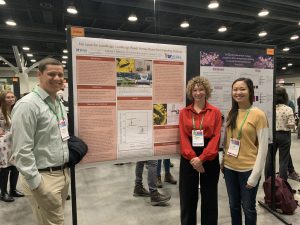
Figure 5. Kathryn Naherny (UF HBREL – undergraduate student scientist) disseminating research information to other scientists through a poster presentation. She is joined by Amy Vu (right) and Dr. Cameron Jack (left), both of the UF HBREL. Photograph – UF HBREL Staff
Communication of results
There are multiple ways that scientists can share the results from their research projects. The first way is communication of the results at research or extension meetings. A research meeting is one likely to be attended only by scientists in the discipline. In the honey bee world, that includes meetings such at the American Bee Research Conference, EurBee, Apimondia, Annual Meeting of the Entomological Society of America, etc. These meetings are attended by scientists, sometimes in the thousands, each presenting a lecture or poster (Figure 5) of their research. In this case, the scientists are communicating their results to peers, i.e. other academic, government or industry scientists.
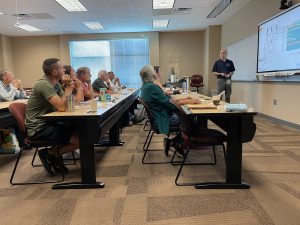
Figure 6. Dr. Jose Marcelino (UF HBREL) disseminating research information to beekeepers through the UF Bee College. Photograph – UF HBREL Staff
An extension meeting is one attended by specific target audiences for continuing education purposes. For example, the target audience could be beekeepers attending the annual meetings of the American Beekeeping Federation, the American Honey Producers Association, any of the U.S. state beekeeper organizations and even local/regional beekeeper organizations (Figure 6). These beekeepers are eager to hear about the latest research advances, especially if the advances lead to positive changes in their beekeeping operations. The information communicated by scientists at these meetings is usually delivered in lecture format, but there may be some hands-on workshops as well. This activity is not research per se, but rather falls under the category of extension. My colleague, Amy Vu, will teach you all about extension the next two months.
These days, research can be communicated through websites, videos, fact sheets, online presentations and social media. The latter includes Facebook, Twitter, Instagram and more (you can find our laboratory’s social media accounts: @UFhoneybeelab). Scientists are getting incredibly creative at disseminating information, allowing information to flow freely, quickly, (and sometimes in need of fact-checking) to the masses.
Finally, and most importantly, science is communicated in peer-reviewed research journals. Honey bee scientists are invited by beekeepers to speak at many local, state and national beekeeping organizations. These same scientists are under university pressure to publish the results in refereed journals. This is something that is hard for many folks unfamiliar with science to appreciate. Publishing a refereed manuscript is the output by which faculty are judged by their administrators. Frankly, universities value refereed manuscripts more than they value likes on Twitter, presentations at industry meetings and electronic factsheets. Thus, I feel it is important to spend a little time talking about a refereed manuscript, given the great emphasis put on this method of research communication.
A refereed manuscript published in a peer-reviewed journal is simply code for “other scientists look at and scrutinize your work before it is published”. Refereed manuscripts all have the same basic organization. The layout of the standard refereed manuscript follows the steps of the scientific method. I list the key (though not all) parts of a typical reach manuscript below.
- Title – This is a concise, hopefully catchy, summative statement of the research project.
- Authors/author affiliations – This is a list of scientists involved in the work. Generally speaking, the “first” author is the one who conducted the research or worked most on the project. Typically, the last author is the one in whose lab the work was conducted. The remaining authors may be listed in order of level of contribution to the research, alphabetically, etc. The authors then list their employers or other affiliations in the affiliations list.
- Abstract – This is a concise summary of the project. It includes a few sentences on project introduction, methods, analysis and discussion. This is often limited to 200-300 words, depending on the journal to which the paper is submitted.
- Keywords – These five to 10 words summarize the key topics or themes of the study.
- Introduction – This section is a discussion of your observations, hypothesis and prediction. Essentially, it is a summary of Steps 1-4 of the scientific method.
- Materials and Methods – This should be a near exact description of how the hypothesis was tested. Any scientist in the field should be able to read the M&Ms and be able to repeat the study exactly. This outlines the scientist’s approach to Step 5 of the scientific method.
- Results – This section includes information on exactly what was found during the study. This is also the section in which the scientist(s) presents the data and data analyses, usually in table or figure format. This is also included in Step 5 of the scientific method.
- Discussion – This is where the authors place their results in a larger scientific context. It includes some speculation, supporting literature analyses and even future predictions. The authors may choose to outline additional projects that would be good to do in the future. This is part of Step 6 in the scientific method.
- Acknowledgments – Here is where the authors thank the individuals who helped with the study in any capacity. This may include technicians, beekeepers, statisticians, the funding agencies, etc.
- References – This is a list of all of the research articles cited throughout the manuscript. This list allows readers to double check the assumptions made throughout the manuscript and the authors to acknowledge the scientific contributions of others in the same field.
What makes these manuscripts “refereed”? Once the science authors have developed their manuscript, they submit the manuscript to a peer-reviewed journal. Scientists try to match the subject of their article with the aims/scope of the journal to which they choose to submit their article. For example, I would not submit a manuscript on honey bee toxicology to a quantum physics journal. Instead, I would submit it to a journal that publishes honey bee, insect, toxicology or similarly themed manuscripts. The editor of the journal receives the submission, reads it and forwards it to two (or more) international scientists who are experts in the field. If I write and submit an article on some aspect of honey bee toxicology to a journal, the editor is going to forward the manuscript to two or more honey bee toxicologists. These individuals, now serving as the “peer reviewers” or “referees,” will read the paper to see if it is worth publishing in the target journal. They review the introduction, determine if the hypothesis is reasonable, ascertain if the correct experiments were conducted to address the stated hypothesis, scrutinize the data analysis and correct faulty assumptions/conclusions in the discussion. They also comment on table/figure utilization, author understanding of the subject, presentation of the information and even grammar. They complete sometimes lengthy reports and forward those to the journal editor whose uses the reviewer reports to determine if the paper: (1) can be accepted as is (no other changes needed, publishable as written), (2) needs minor revisions (the authors need to make minor changes and resubmit), (3) needs major revisions (the authors need to rework entire sections of the manuscript), or (4) should be rejected (the paper does not fit the theme of the journal, the science is bad, the experiment was poorly performed, etc.). The editor has full authority to determine the fate of the manuscript. Some journals, such as Nature/Science, have incredibly high rejection rates. Others do not. Scientists hope that their manuscripts are scientifically rigorous and stand up to the scientific scrutiny of the international experts.
There is a reason that manuscripts undergo peer review. Anyone can publish anything nearly anywhere. I can publish my research in a bee journal or other periodical with no scrutiny. I can speak about my research at bee conferences, and you might believe it. I might post our findings on social media and beekeepers everywhere follow my suggestions. However, science advances best when expert peers review one another’s research to see if it is meritorious and appropriately conducted. The peer review process is science’s quality control. It is not a perfect system (and I could discuss this forever) but no other alternative is as good. Faculty at LGUs are expected to conduct research, yes; but more importantly, they are expected to publish it in peer-reviewed journals. Failure to do that, and the research remains unvetted and in danger of dying in someone’s lab journal. Research is only over the finish line once it is published in a peer review journal. At that point, it moves into the court of public opinion, scrutiny, trial and error (which you could argue is a more informed refereed process), but only after other scientists took their pound of flesh first.
Basic vs. applied research
I fall into the camp that believes research is best represented as a spectrum, where basic research is on one side of the spectrum and applied research is on the other. You get hybrids of the two as you move from one to the other. In my experience, most research is not purely basic or strictly applied. What do I mean by this?
Well, scientists almost always discuss applied research at beekeeper meetings. Applied research (at the risk of using the words in their own definition) is research that leads to some sort of application. This is exactly the type of research most beekeepers want from their LGU’s bee scientist(s). Applied research includes testing various pollen patties in colonies to determine their impact on brood and bee production, finding new strategies to control Varroa, developing a new hive style that improves colony overwintering success, etc.
Basic research, on the other hand, has no immediate application and simply answers questions that help us understand a system we are studying. These types of projects often are not discussed at beekeeper meetings. Basic research with honey bees might include determining how honey bees find new nest sites when swarming, how a particular compound acts as an acetylcholinesterase inhibitor in honey bees and how small hive beetles trick honey bees into feeding them.
Now, an astute reader will notice that there likely is no such thing as purely basic research. You could argue that all basic research could, someday, end up having a practical application. What seems basic now may end up having an important application later. I can even show you that with the three examples of basic research that I provided previously. You could argue that knowing how honey bees find nest sites could lead to the development of optimum hive styles. Knowing how a compound acts as an acetylcholinesterase inhibitor in honey bees could lead to the production of safer compounds to use to control Varroa. Finally, knowing that bees feed small hive beetles could lead to the development of control agents that are delivered in sugar water, through bees, and to the beetles.
How is research funded?
Research costs money, sometimes lots of money. Before I was a professor, I assumed that universities pull up to your laboratory with a dump truck full of money that they dump right at the front door. In fact, I assumed they did this monthly, providing you all the funds you will ever need to conduct research. Well guess what? That does not happen. I was also under that faulty assumption that everything in a university laboratory was bought/paid for by the university. Surely, you only needed to make a reasonable equipment request to your administrators and they would trip over themselves wanting to get you what you need. That, too, was incorrect.
Do not hear me wrong. Administrators at LGUs are among a laboratory’s biggest advocates and will certainly help carry the financial burden when they can; but they often cannot, meaning that the laboratory leader has to be the chief fundraiser for the laboratory. I will list a few key ways that research is funded at LGU laboratories, with a promise to discuss these in greater detail in the forthcoming July article in this series.
(1) Competitive grants – This is a very common method used to fund research. A grant is a monetary award given by an agency to a scientist or group of scientists to conduct a specific series of research projects. To receive the award, the scientist had to develop a proposal, usually in response to a “request for applications” (RFA) made by the agency. For example, the USDA National Institute for Food and Agriculture (NIFA) has a specific funding program on pollinator health. They put out a RFA once a year. The RFA will include specific instructions on how to develop a proposal and what they want to fund. The scientist, in turn, will develop a proposal that aligns with the goals of NIFA outlined in the RFA. The proposal contains background information, hypotheses to be tested, methods the scientist plans to use to test the hypotheses, expected results, a budget, list of collaborators, letters of support and a lot of other information required by the agency and the scientist’s host institution. Proposals are considerable work to develop, taking significant time, resources and energy.
The scientist(s) must submit the proposal by a specified deadline, at which time the sponsoring agency organizes a review panel of scientists that reviews the merits of many proposals, rank them and provides the rankings to agency staff. The staff then works their way down the ranked list, awarding funds until they run out of funds to award. The funding rate of proposals, especially among the federal granting agencies, is low, often <10%. Some of the best grant writers in my department write seven to eight proposals per year, only getting one or two of those funded. Even still, there are many sources of funding for honey bee research. Such funding agencies include USDA NIFA, National Science Foundation, National Institutes of Health, Project Apis m (PAm), USDA APHIS, etc. I will share a lot more about grants in my July article.
(2) Contracts – A contract is when a company, individual, organization, etc. approaches a scientist about conducting very specific work that the organization wants conducted. For example, one of the beekeeping equipment supply companies may have developed a new type of pollen patty that they wanted tested by a scientist. Perhaps a wildflower seed company wants someone to test their new seed mixture to see how attractive it is to pollinators. A chemical company may have developed a new compound and want to know its impact on bees in the field.
In these and other similar cases, the scientist will develop a scope of work (SOW, a scaled down proposal) that includes the problem that will be addressed, how it will be tested and a budget. The scientist provides the SOW directly to the interested party who will determine whether or not to fund the research directly. Contracts usually are not competitive. A company/industry representative or individual approaches the scientist directly, asking them to perform the work and agreeing to fund them through a contract.
I will make a quick note here to share that for grants and contracts, money does not flow directly to the scientist. Instead, the funding agencies/individuals provide the money to the institution, which then enters a contractual agreement with the funding agency/individual to perform specified work as outlined in the SOW or research proposal. I share this to note that some beekeepers worry that contracts lead to nefarious work by the scientist (i.e. that the company/individual/etc. is “buying” services and favors from the scientist). This simply is not true. All work of this type is done through contracts mutually agreed upon by both parties, with the scientist’s institute (rather than the scientist themselves) being the responsible party and the receiver of the funds. There is significant scrutiny and oversight by the scientist’s home institution. Can there be abuse? Yes. Yet it is not nearly as common as some folks suspect.
(3) Unrestricted free gifts – This final way to receive money for research is, essentially, the donation route. Individuals, groups, businesses, etc. can make a monetary donation to a scientist’s program. I will stress that this money does not go to the scientist’s personal bank account. Instead, it goes through the university’s development office (fancy title for their fundraising arm) and routes to the scientist’s home department for their programmatic use. These donations can range from $100 to $1 million or more. Often, the larger donations can be used to create “endowed” positions. Endowed positions usually come in three types: endowed professor, endowed chair, eminent scholar, with the money needed to create each position being greater as you move up the chain. Endowment money will be safely invested by the university, with the funds generated from it yearly (usually about 4%) going to support the scientist’s research program. To illustrate this, a $1 million endowment will generate ~$40,000 for the scientist to use each year. Smaller donations are not used for endowments and, instead, are spent by the scientist however they see fit.
Why is this called an “unrestricted free gift”? This is a very important question, and the answer distinguishes this type of money source from those of a contract or grant. The “free gift” part means that the money was given to the scientist’s program (again, through the university) with no strings attached. The individual/company/group making the donation cannot demand anything in return. The scientist is not agreeing to conduct a specific research project as a condition of receiving the funds. The money is simply a donation made to support the scientist’s program however they see fit to use it (equipment, supplies, new colonies, staff salary, etc.). Endowments are the one exception to this as the donor can specify, in general terms, how they want the funding spent. For example, they may only want it to be used to support graduate student stipends, or work on honey bee disease/pest control.
Honey bees as research models
Honey bees are one of the most studied insects on earth. There are research laboratories focused on honey bees in many (maybe most) countries, with some countries (such as the U.S.) having dozens or more of such laboratories. The scientists at those laboratories may study honey bees from a beekeeping/colony health and production perspective, as model research organisms, or both. This goes back to my discussion on basic vs. applied research. As I noted then, beekeepers interact with bee scientists most from an applied research perspective, when the scientist shares about a specific project they conducted on behalf of beekeepers. However, honey bees and their colonies are remarkable research models for scientists who investigate basic research topics as well.
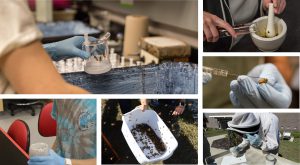
Figure 7. A collage of scientists in action. Photograph – UF HBREL Staff
Honey bees have something to offer nearly anyone interested in any of the scientific disciplines (Figure 7). Neurobiologists may study honey bee colonies to gain greater insight into how the human brain function. Ecologists may study honey bee contributions to healthy and sustainable ecosystems. Mathematicians may want to model the honey bee nest architecture. Biologists may be interested in a particular type of honey bee behavior. Apiculturists (the name given to scientists who study honey bees from a beekeeping/production perspective) may be interested in controlling a particular bee pest or search for a way to improve queen health and longevity. The list goes on and on. I love attending research meetings where honey bee scientists present their work. You would be amazed at what scientists study regarding honey bees, their colonies, social organization and environmental impact. There are many careers waiting to be had in the honey bee research world!

Figure 8. Using Google Scholar to find a list of refereed manuscripts for any scientist. You can get to Google Scholar by searching “scholar” in Google. That will take you to a new search page. Once there, type the name of the scientist in question and then add “honey bee” after their name.
Honey bee research at the UF HBREL
I have spent considerable time talking about science and research in general. I will conclude this article discussing what members of the UF HBREL study. My team and I plan to discuss some of our research in future contributions to this article series. Thus, I will not go into great detail about any one project here. I will also share that my complete library of refereed publications (i.e. a list of all the research projects I have published) can be found by visiting this link https://entnemdept.ufl.edu/honey-bee/research/honey-bee-husbandry/publications-by-year/ or Googling “UF honey bee lab” and then clicking through this pathway: research (top of page) > publications by year. As a quick cheat, you can find refereed manuscripts for other scientists at their institutional website or by going to Google Scholar (a Google search engine just for refereed manuscripts) and searching the scientist’s name + “honey bee” (for example: James Ellis honey bee)(Figure 8). Now, on to what my team and I study at UF…
1) Honey Bee Husbandry – Improving the sustainability of beekeeping. Most of the research in this category (the largest of all our research efforts) encompasses four research emphases: (1) integrated pest management control of honey bee pests/diseases, (2) understanding the proximal causes of colony losses, (3) the impacts of pesticides on bees and (4) understanding the spread and mitigating the threat of African honey bees. Correspondingly, my team and I have published on the impacts of pesticides on honey bees, the spread, biology and control of honey bee pests/pathogens, honey bee nutrition, African honey bees and honey bee colony losses. Furthermore, we have co-led the development and compilation of research methods on honey bees, their pests/predators and hive components.
2) Honey Bee Natural History, Biodiversity and Conservation – Understanding the relationship between honey bees and their environment and working to conserve honey bee populations for the benefit of healthy ecosystems. This represents a newer field of investigation for my team. We are keenly interested in the health of wild, natural populations of honey bees, particularly in southern Africa. The studies in this category fall within our basic research interests. We are developing/refining methods that can be used to differentiate between the various subspecies of honey bees. Thus far, we have published the sequenced mitochondrial genomes of a number of Apis species and Apis mellifera subspecies. Additional projects in this area include understanding why honey bees nest where they do, the epidemiology of wild honey bee colonies, the contributions of honey bees to natural ecosystems, honey bee natural history, how complex behavioral interactions develop between honey bees and their nest invaders and general biodiversity topics. We hope our growing efforts in this subject area produce an interest in honey bee conservation in light of the high gross loss rates of managed colonies.
3) Integrated Crop Pollination (ICP) – Determining the contributions of unmanaged bees to the pollination of various cropping systems and working to conserve native pollinators through sound ecological principles and understanding. Admittedly, I do less work in this area now than in the past. However, our past work here encompassed efforts to study the impact of native pollinators on U.S. agriculture and to understand native pollinator ecology in general. The results from this research may someday allow us to develop targeted conservation practices for native pollinators and make recommendations to Florida and U.S. farmers about how to enhance native pollinator biodiversity on their farms. Ultimately, we want to help growers achieve adequate pollination of crops by integrating current practices focusing on pollinator management and general wellbeing. My colleagues and I published research on ICP, including defining and introducing the topic to science. Furthermore, we determined the contributions of unmanaged pollinators to some Florida crops, determined how native wildflowers impact pollinator populations, worked to understand aspects of the biology of two native bees in Florida and even created a citizen science project to introduce the public to the topic of pollination.
The UF HBREL’s research has a broad impact for beekeepers, the industry, growers and the public. Our team actively manages 30+ research projects at any given time. The results of these projects are peer-reviewed scientific publications in refereed journals, better positioning for future grants, enhanced extension programs, fulfilling instructional efforts and immediate and long-term solutions to identifiable research needs. Thanks for joining me on this journey through a look at honey bee research.








